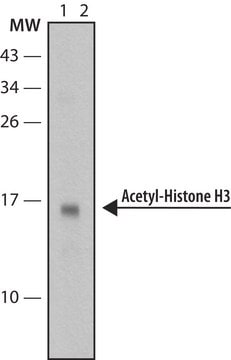General description
Histone H3 (UniProt: P61830) is encoded by the HHT1 (also known as YBR010W, YBR0201, HHT2, SIN2, YNL031C, N2749) gene (Gene ID: 852295) in yeast. Histone H3 is a core component of nucleosome. Nucleosomes wrap and compact DNA into chromatin, limiting DNA accessibility to the cellular machineries which require DNA as a template. Histone H3 can undergo various post-translational modifications that either activate or repression gene expression. Histone H3 can undergo mon-, di-, or trimethylation. Trimethylated H3K27 is shown to be tightly associated with inactive gene promoters and monomethylated H3K27 is associated with active promoters. The dimethylated H3K27 has a distribution pattern similar to H3K27. Histone H3 can also undergo acetylation at Lys9, 14, 18, 23, 27 and 56. Acetylation of histone H3 leads to transcriptional activation. Acetylation of histone defines the openness of chromatin as acetylated histones cannot pack as well together as deacetylated histones. H3K27ac as an important enhancer mark that can distinguish between active and poised enhancer elements and enhancer proximal genes that lack H3K27ac enrichment display lower expression levels compared with the average enhancer proximal gene. It is shown that amounts of H3K27ac is gradually declines fom the earliest pronuclear stage to 8-cell stage, corresponding to the major embryonic genome activation (EGA), followed by re-acetylation of H3K27 from the morula stage onwards accompanying the first cell lineage specification in IVF embryos. In Drosophila, H3K27ac is present at high levels in early embryos and declines after 4 hours as the level of trimethylated H3K27 increases. (Ref.: Creyghton, MP et al. ( ). Proc. Natl. Acad. Sci. USA 107(50); 21931-21936; Tie, F et al (2009). Dvelopment 136 (18); 3131-3141)..
Specificity
Recognizes Histone H3 acetylated on lysine 27.
Immunogen
Epitope: Lys27
KLH-conjugated linear peptide corresponding to 11 amino acids from the N-terminal region of human histone H3 acetylated on Lysine 27.
Application
ChIP-seq Analysis: Chromatin immunoprecipitation was performed using the Magna ChIP HiSens kit (cat# 17-10460), 2 µl of anti-acetyl-Histone H3 (Lys27) antibody (cat# 07-360), 20 µL Protein A/G beads, and 1e6 crosslinked HeLa cell chromatin followed by DNA purification using magnetic beads. Libraries were prepared from Input and ChIP DNA samples using standard protocols with Illumina barcoded adapters, and analyzed on Illumina HiSeq instrument. An excess of fourteen million reads from FastQ files were mapped using Bowtie (http://bowtie-bio.sourceforge.net/manual.shtml) following TagDust (http://genome.gsc.riken.jp/osc/english/dataresource/) tag removal. Peaks were identified using MACS (http://luelab.dfci.harvard.edu/MACS/), with peaks and reads visualized as a custom track in UCSC Genome Browser (http://genome.ucsc.edu) from BigWig and BED files. The highest 25% of peaks identified in the 07-360 dataset showed 96% overlap with peaks identified in the ENCODE H3K27Ac BROAD Histone track for HeLa S3.
Anti-acetyl-Histone H3 (Lys27) Antibody is a rabbit polyclonal antibody for detection of Histone H3 acetylated on lysine 27. Also known as Anti-H3K27ac this antibody is published in peer reviewed journals and is specificity verified by dot blot (DB) and validated in ChIP, ChIP-seq, WB, DB, Mplex.
Research Category
Epigenetics & Nuclear Function
Research Sub Category
Histones
Quality
Evaluated by Western Blotting in acid extract of HeLa cells treated with 5 mM sodium butyrate.
Western Blotting Analysis: A 1:5,000 dilution of this antibody detected acetyl-Histone H3 (Lys27) in acid extract of HeLa cells treated with 5 mM sodium butyrate.cells
Physical form
Rabbit polyclonal antiserum with 0.05% sodium azide and 30% glycerol.
Unpurified
Storage and Stability
Maintain for 2 years at -20°C from date of shipment. Aliquot to avoid repeated freezing and thawing. For maximum recovery of product, centrifuge the original vial after thawing and prior to removing the cap.
Analysis Note
Control
Acid extracted proteins from HeLa cells treated with sodium butyrate
Other Notes
Concentration: Please refer to the Certificate of Analysis for the lot-specific concentration.
Legal Information
UPSTATE is a registered trademark of Merck KGaA, Darmstadt, Germany
Disclaimer
Unless otherwise stated in our catalog or other company documentation accompanying the product(s), our products are intended for research use only and are not to be used for any other purpose, which includes but is not limited to, unauthorized commercial uses, in vitro diagnostic uses, ex vivo or in vivo therapeutic uses or any type of consumption or application to humans or animals.









